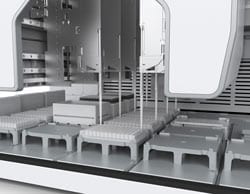
What is needed to adapt to the changing needs of life science researchers?
Until now, life science researchers had a narrow set of expectations for automation systems. The main focus of laboratory automation providers has been to develop liquid handling systems for high-throughput workflows processing very large samples numbers, primarily in screening laboratories. In this model all samples go through the same protocol, usually confined to a small number of simple steps, such as serial dilutions or simple plate-to-plate liquid transfers. While effective in these instances, the changing needs of life science research caused scientists to rethink automation and expect more capabilities and easier access.
Researchers continue to want high throughput, but they also want to improve data quality and translate it into shortened research timelines and reduced costs. Driven by the need to produce high-quality data in a high-throughput environment, researchers look to reduce manual intervention and automate workflows from sample preparation phase through data analysis.
Highly flexible systems that facilitate integration of multistep processes and extend automation to more steps in the workflow can satisfy this new expectation. Industry responded to this need with recent introductions that make it possible to extend the use of automation to a wide range of life science assays and workflow steps, increasing access and allowing laboratory personnel to craft their own flexible automation solutions. Workflows can now benefit from flexibility, modularity, and integration so that a finite set of well-designed tools can be linked together by a broader group of laboratory personnel in order to tackle complex, multistep processes.
The benefit of introducing greater flexibility is very apparent in some of the most common laboratory applications. For example, speeding up sample preparation for next-generation sequencing and liquid chromatography-mass spectrometry allows scientists and laboratory personnel to employ sensitive and sophisticated techniques on medium to large sample numbers, while maintaining the highest levels of data integrity. Some factors driving this trend are the need to gain information earlier in the drug discovery process in order to reduce costs. It is a great advantage to run primary and secondary assays in parallel to shorten the overall timeline and reduce risks when choosing candidate compounds to pursue in later development stages. As a result, it is possible to advance candidates based on broader criteria, and thus increase the likelihood of success down the road. Beyond raising throughput in these instances, automation also improves reproducibility in complex multistep protocols by reducing the likelihood of random execution errors.
Automation flexibility can be improved with features that address significant bottlenecks impacting the speed of the overall process. For example, the ability to integrate multiple instruments frees scientists from individually defined solutions and enables flexible, modular options that can be modified based on existing laboratory instrumentation and changing experimental conditions. Second, the software driving the instrumentation should reflect the user’s perspective, rather than the traditional instrument focus, as this makes it easier for laboratory personnel to transfer their methods and protocols directly into automated solutions.
With regard to liquid handling, two key features that greatly increase the flexibility of an instrument include the pipetting head and the presence of robotic arms. Incorporating a multispan pipettor with truly independent x- and y-axis variability (Figure 1) makes it possible to move beyond the confines of high-density formats to a wide variety of commercially available vials, tubes, and plates, including types that are assay specific, such as Maldi and Caco-2 plates. While many automation systems incorporate robotic arms either as part of the main system or as add-ons, their functionality varies. An ideal robotic arm should have the finesse and articulation necessary to carry out critical assay steps on deck, such as the assembly of vacuum manifolds. It should also reach well off deck to pass plates to detectors and incubators in order to integrate complete workflows and reduce bottlenecks caused by a reliance on manual intervention. The need for increased flexibility necessitates an expansion of modularity to key components of the instrument, such as the use of individual pipetting cards and easy-to-move on-deck accessories.
The Latest Bing News on:
Rethinking Automation
- Rethinking Atenolol as a First-Line Antihypertensiveon May 5, 2024 at 5:00 pm
The β-blocker atenolol is used widely as a first-line treatment for hypertension and as a reference drug in clinical trials. Prompted by a finding that the angiotensin-receptor blocker losartan ...
- Rethinking automation in the age of artificial intelligenceon April 28, 2024 at 7:40 pm
The new automation mindset cultivates plasticity within companies, encouraging continuous learning, evolution, and adaptation.
- Rethinking the Weakest Link in State Government Cybersecurityon April 24, 2024 at 2:07 am
Recent cyberattacks in Fulton County, Ga., Contra Costa County, Calif., and the Office of the Colorado State Public Defender have prompted widespread delays and forced state and local entities to shut ...
- Rethinking Leadership: Are You Willing to Be a Servant Leader?on April 21, 2024 at 5:00 pm
Management positions are no longer the stuff of dreams. Is it because we were misled about what they really entail? I explored this in a recent paper in Organizational Dynamics, suggesting that ...
- Rethinking drinking? Doctors say drink less, or not at allon April 18, 2024 at 3:21 pm
Drinking may be affecting your health more than you know. During Alcohol Awareness Month, 10 On Your Side looked into what kind of effects it has on you. Drinking may be affecting your health more ...
- Rethinking Groupthinkon April 17, 2024 at 5:00 pm
The concept of "groupthink," first identified by Irving Janis, refers to the phenomenon in which group members quickly align on certain decisions without critically evaluating or suppressing ...
- Larry Fink’s Question Of When Retirement Begins Is A Systems Challengeon April 9, 2024 at 7:12 am
Rethinking retirement and retirement age requires ... Today, technology, particularly automation, is making work less physically demanding, theoretically making it possible for people to work ...
- Game on: Rethinking change management for the digital eraon April 7, 2024 at 5:00 pm
To bridge the chasm between ESG aspiration and implementation, businesses must refine their focus on the ESG agenda to clearly define the importance of… 2024 GEP Procurement & Supply Chain Tech Trends ...
- Rethinking how to clean and style your homeon April 6, 2024 at 9:04 am
Spring can be a great time to clean your space and start fresh – but it’s not always easy to do. Today, we have tips on how to finally get rid of clutter and find ways to make your space feel ...
- Rethinking the Grind: The Rise of the 32-Hour Workweekon March 21, 2024 at 7:55 am
Although the 40-hour workweek has been the standard in the U.S. for more than eight decades, remote work, automation, and a growing focus on well-being have put pressure on the norm. In recent ...
The Latest Google Headlines on:
Rethinking Automation
[google_news title=”” keyword=”Rethinking Automation” num_posts=”10″ blurb_length=”0″ show_thumb=”left”]
The Latest Bing News on:
Automation systems
- AGVs Transform Large Vehicle Production: The Future of Automated Manufacturingon May 8, 2024 at 7:27 am
A large vehicle manufacturing company has improved the way large vehicles are produced by integrating Automated Guided Vehicles (AGVs) into their assembly line. This innovative approach has broken ...
- Shubham Automation selects Dassault Systems platform for faster product developmenton May 8, 2024 at 6:00 am
By adopting this portfolio of solutions, Shubham Automation has a significant leap in its development processes, the company said.
- Cadence Design Systems: A Lot To Like, But Not At This Priceon May 8, 2024 at 4:16 am
Cadence Design Systems is a leading company in the electronic design automation and semiconductor intellectual property industry. See why CDNS stock is a Hold.
- Building Automation: Extreme Comfort with Hidden Threatson May 7, 2024 at 11:50 am
In the fast-paced world of smart homes and buildings, indoor air quality often takes a backseat. The MOX technology offers a seamless solution to make your space smarter and ...
- Bosch Rexroth Showcasing Complete Factory Automation Solutions at Automate 2024on May 7, 2024 at 11:09 am
The latest technology demos and informative exhibits highlight Bosch Rexroth’s broad range of factory automation technologies at Booth 424 at Automate 2024 in Chicago, Illinois May 6-9.
- Water Automation and Instrumentation Market Growth: Anticipated 8.1% CAGR with a Projected Value of USD 48 Billion by 2033on May 7, 2024 at 7:42 am
A comprehensive analysis by Future Market Insights (FMI), a well-respected market research and consulting firm certified by ESCOMAR, anticipates significant growth in the water automation and ...
- Mechanoid Unveils Revolutionary AI and Automation Suite to Boost Small Business Sales and Efficiencyon May 7, 2024 at 7:40 am
Mount Waverley, Victoria - Mechanoid, a leader in business optimization and automation solutions, has announced the launch of its new software aimed at transforming small business marketing and sales ...
- Building Automation Systems Market Analysis: Industry Reaching USD 96,264 million by 2033on May 6, 2024 at 11:54 pm
Outbound Tourism in Germany: Projected to Reach USD 292,799.9 Million by 2034, With a Forecasted Growth Rate of 9.8% Government Initiatives: Many governments are offering incentives and regulations ...
- Hamilton BiOS Automated Storage Systems to Strengthen UK Biobank’s Efforts Towards Improving Human Healthon May 4, 2024 at 6:48 pm
Enhanced and expanded automated sample storage is central to UK Biobank’s new Manchester Science Park facility.United States - May 4, 2024 — ...
- New laboratory automation system is live at Littleton hospitalon May 1, 2024 at 2:22 pm
Littleton Regional Healthcare hosted a ribbon-cutting ceremony to commemorate the implementation of its brand-new laboratory automation system, featuring state-of-the-art chemistry and hematology ...
The Latest Google Headlines on:
Automation systems
[google_news title=”” keyword=”automation systems” num_posts=”10″ blurb_length=”0″ show_thumb=”left”]










